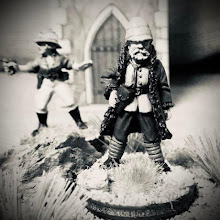"Your highness," began the Grand Chancellor of Redsteinerberg,"do you think it is wise to tour your other holdings while in the midst of the campaign against Bluehofen?"
"Sure. What could go wrong?" replied the Prince of Redsteinerberg?
Redsteinerberg has been down one player who has experience in gaming though his team put up a valiant fight during the fourth battle. The fourth battle is based on Scenario 5: Bridgehead from One-Hour Wargames by Neil Thomas. After the victory of the fortified villages, the army of Bluehofen has discovered a bridge that is undefended by Redsteinerberg. If Bluehofen can just get a bridgehead established, the fortunes of war might change . . .
The battlefield showing the various entry points for both sides.
Redsteinerberg has 3 Infantry, 2 Artillery and 1 Cavalry.
Bluehofen has 4 Infantry, 1 Artillery and 1 Cavalry.
The battle starts with one Bluehofen unit placed north of the river within 6 inches of the bridge. Starting on turn 2, Bluehofen can bring one unit every turn at point D. Redsteinerberg moves first but has to roll for it's deployment. The will receive 2 units on Turns 1, 3 and 5. A roll of 1-2 brings the units at Point A, 3-4 brings them on at Point B and a 5-6 at Point C. Victory is attained by having no enemy units on the north bank of the river within 12 inches of the bridge.
The situation at the end of Turn 3: Four units of Redsteinerberg units enter at Point A and use the woods to cover their advance.
Turn 3: The valiant Grenadier Guards were the forlorn hope as other infantry move up and artillery move into position.
The view from behind the Bluehofen lines. Long range fire commences.
Though I don't have a picture of it, the Bluehofen cavalry aggressively attack their counterparts in Red but they were able to bypass and get behind them leaving their infantry support behind. The commander of the cavalry, spotting an infantry target and charged. Though not successful, after another charge they would destroy the infantry. In the background you can see the Redsteinerberg artillery that came in at point D. Though unsupported, the artillery commander kept up a continuous barrage that along with some musket fire, destroyed the gallant Grenadier Guards.
The Redsteinerberg artillery.
Outflanked, the infantry quickly turns and fires their muskets . . . and then in one of the strangest events of the war, the cavalry forgets to charge for two straight turns and is blown out of their saddles. Meanwhile, the other Bluehofen infantry concentrate their fire power on one of the Redsteinerberg infantry units and destroy it.
The last infantry unit is hit in the flank - but they hold!
View from above.
Since the infantry survived the charge, the cavalry had to retreat 6 inches facing the enemy. Notice that the Redsteinerberg cavalry has been eliminated and the "Reds" have decided to fight to the bitter end for their prince.
The Redsteinerberg infantry turns and fires their muskets, but it is not enough to stop the rampaging horsemen from Bluehofen. This time the unit will be overrun and put to the sword.
The artillery continues to fire as the artillery commander vows she will never abandon her guns!
The end of the game as one battery of guns is destroyed by musketry and artillery.
A stunning defeat for Redsteinerberg. At first the Redsteinerberg infantry were posed to establish a great firing line but were abandoned by their cavalry exposing their flank. If it could have gone wrong - it did for Redsteinerberg. The wild man of the game was the Bluehofen cavarly commander who was awarded the Order of the Lion by the Grand Duke himself. After four battles the campaign is now tied at 4 - 4.


















I am enjoying this series. There is something attractive about the simple presentation of the terrain and the armies. The Redsteinerberg battle flags add just that little extra 'something', too...
ReplyDeleteAggressive tactics by Bluehofen have paid off! Nice report Neil.
ReplyDelete